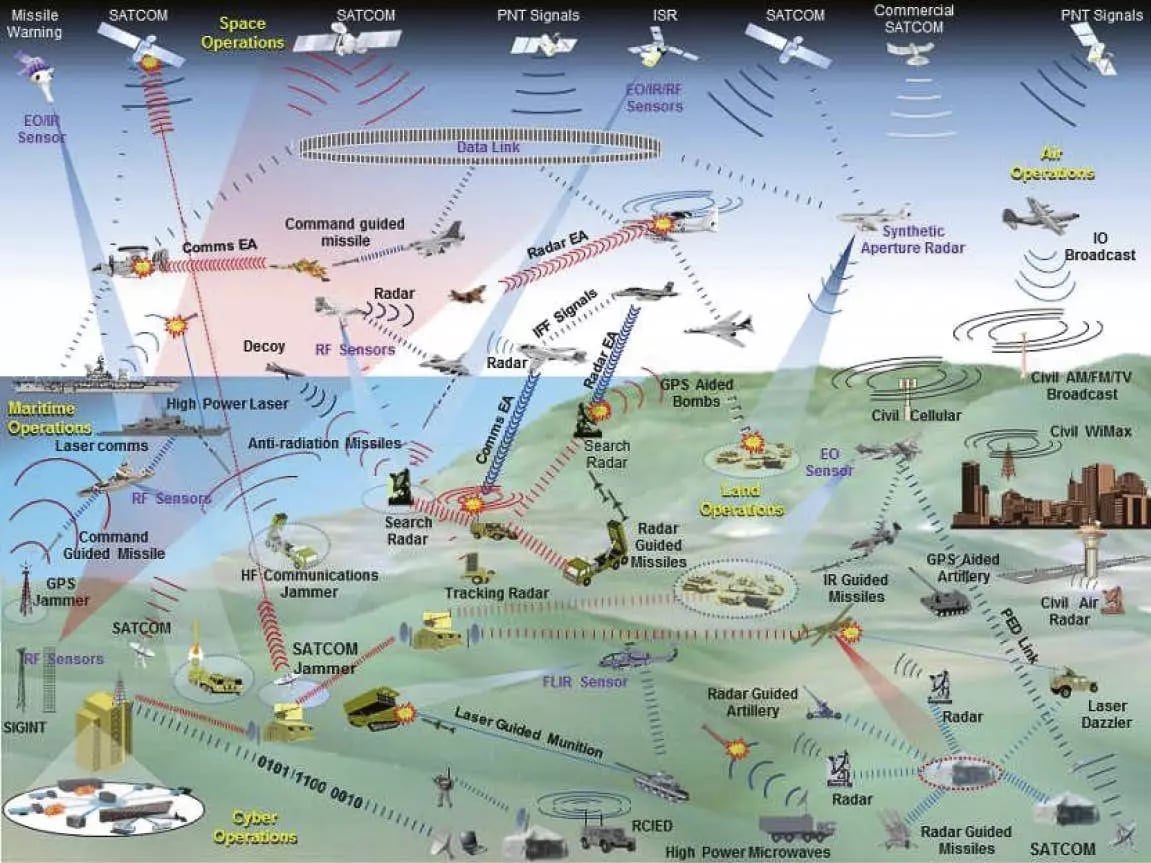Many critical military operations around the world are increasingly relying on a variety of electronic warfare devices for a range of threat suppression, detection, and neutralization activities. This means that numerous devices operating across the RF spectrum including low-frequency devices in the VHF band and mmWave devices in the Ka band are necessary. As shown in Figure 1, when many electronic warfare devices are in use, a large number of signals are being sent and received and crossing paths. Therefore, it’s easy for any one of these devices to experience issues with interference if proper filtering techniques are not in place.
 Figure 1. This illustration depicts the wide variety of signals across the RF spectrum that could be in use for military operations at any given time. Source.
Figure 1. This illustration depicts the wide variety of signals across the RF spectrum that could be in use for military operations at any given time. Source.
To further complicate this scenario, many military applications today need to be used in increasingly smaller spaces such as unmanned platforms, aircrafts, ships, or tanks, making size, weight, and power (SWaP) a big concern. Thus, to filter out unwanted signals in a crowded RF environment, more components cannot simply be added to a device to get the job done. Instead, the ideal solution to this complex filtering issue would be a compact, lightweight wideband tuner architecture with the ability to intelligently acquire and filter signals from a wide number of bands. However, developing this type of component presents quite a few challenges.
In one of our new microapp presentations we highlight how Knowles Precision Devices and Criteria Labs are working together to address these challenges. Our concept for this small wideband tuner architecture involves both shrinking the pre-select switch filter bank using our high K ceramics and using Criteria Labs' expertise to package the filter bank in a way that will significantly reduce size.
In this presentation we first discuss how we can shrink the pre-select filter bank by developing a four-channel switch filter bank that does not require tuning and can operate from 2 – 18 GHz. With our expertise in materials science, we can use our proprietary high K ceramics to develop the filters for the filter bank that are significantly smaller than those constructed with traditional materials such as RO4350b or Alumina. As shown in Table 1, filters designed with our custom CG ceramic can be made ~55 percent smaller than those made with RO4350b.
|
Material |
RO4350b |
Alumina |
PG |
CF |
CG |
|
dK |
3.7 |
9.6 |
12.5 |
25 |
67 |
|
Effective K |
2.8 |
6.5 |
8.2 |
15.1 |
36.8 |
|
Wavelength @10 GHz (inch) [mm] |
0.707 [17.96] |
0.462 [11.73] |
0.412 [10.46] |
0.304 [7.72] |
0.194 [4.93] |
|
Percent Reduction |
----------- |
34.70% |
41.70% |
57.00% |
72.60% |
|
Size (inches) |
0.320 x 0.450 |
0.328 x 0.323 |
0.336 x 0.295 |
0.347 x 0.246 |
0.360 x 0.177 |
We then discuss how we are working with Criteria Labs to further reduce the size of this wideband tuner architecture by simultaneously developing a packaging concept for a 3D stacked filter bank. By stacking the filters on the top and bottom of the interposer board, we can shrink the overall size of the filter bank significantly. This is challenging to do because we need to be sure we can pass all the signals to and from the filter banks to the bottom of the board without disrupting the signals or reducing the performance of the filters while also maintaining our spacing.
To learn more about this concept and see how Knowles Precision Devices and Criteria Labs are working together to overcome the many challenges associated with developing a wideband tuner architecture that also reduces SWaP, watch this webinar today.

